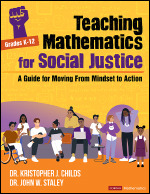Teaching Mathematics for Social Justice, Grades K-12
A Guide for Moving From Mindset to Action
- Dr. Kristopher J. Childs
- Dr. John W. Staley - Baltimore County Public Schools, Maryland
Corwin Mathematics Series
Mathematics & Numeracy
Your journey to becoming a social justice mathematics educator begins here.
Every journey has a beginning—a starting point—where you take a moment to set your sights on your next destination carefully. Teaching mathematics for social justice (TMSJ) means reimagining your mathematics classroom in a way that serves more children better–as a place that lifts mathematics up as a tool for students to analyze and understand the worlds around them, celebrate their unique identities and their communities, and become agents of change. For any K-12 educator who values these goals Teaching Mathematics for Social Justice, Grades: A Guide for Moving from Mindset to Action can be the start of a transformational journey.
Guiding you in planning, implementing, assessing, and showcasing social justice mathematics lessons and helping children apply their learning beyond the classroom, this book:
- Encourages self-reflection on the “why” of your teaching and examines your own mindset about mathematics
- Provides a step-by-step action plan for creating equitable and socially just mathematics classrooms that focus on rich and collaborative mathematics learning
- Incorporates interactive reflection prompts, self-assessments, and activities throughout the journey
- Describes culturally responsive teaching practices to better respond to the instructional needs of the diverse individuals in your classroom
- Offers activities to identify what current events and social issues are important to children and their families
- Inspires you to remain steadfast in their journey of growth toward becoming a social justice mathematics educator
Complete with sample lessons, online resources, and practical tools, this guide will empower you to better understand the children in your classroom, leverage their strengths, and make mathematics learning relevant and useful as they use mathematics to address the issues they care about. Start your journey towards becoming a social justice mathematics educator today.
This book is for any educator, parent, and activist who understands that education is not neutral, for any citizen of this world who believes that a quality education allows its recipients to understand, thrive, and transform their world. An education thusly positioned changes lives and benefits humanity.
Teaching Mathematics for Social Justice, Grades K–12: A Guide for Moving From Mindset to Action is a thoughtfully designed guide that helps math educators know their children, use practices to highlight their strengths, and ensure the math they teach is relevant. This book will assist you in designing experiences for children to learn mathematics skills and concepts and use them to make the world a better and more just place! Begin your journey as a culturally relevant educator by taking this guide and using it to reimagine your math classroom.
In a climate where equity and diversity efforts are under attack, Childs and Staley courageously advocate for teaching mathematics for social justice. Their framework centers children, incorporates standards-based mathematics instruction as well as culturally relevant and responsive teaching, and has equity as its foundation. This book is a must read for K–12 teachers who want to engage in continuous improvement of their instructional practices.
Teaching Mathematics for Social Justice, Grades K–12: A Guide for Moving From Mindset to Action is a book that helps educators develop a framework for teaching mathematics with a focus on social justice. Each chapter of the book includes a “Reflect and Action” box, which guides readers to think critically throughout their journey toward teaching mathematics for social justice. Overall, this book is a useful resource for those who are committed to promoting social justice in their mathematics teaching practices.
Enhance your justice journey with this excellent resource. Offering accessible and actionable guidance to effectively integrate a Teaching Math for Social Justice approach in K–12 classrooms, this book includes practical tools and tasks to plan, enact, and reflect on instruction that centers children, cultivates joy, and sparks action to make a positive difference in our world with mathematics.
Childs and Staley have created a practical and powerful resource for teachers who are looking to design inclusive classrooms and working to ensure that ALL students have access to rigorous and important mathematics instruction. This will be a valuable resource that I will undoubtedly return to for guidance and support as I continue to engage in this work.
Teaching Mathematics for Social Justice, Grades 6–12: A Guide for Moving From Mindset to Action offers a transformative framework for educators to cultivate equity in the classroom. From understanding personal biases to engaging communities, this guide provides practical strategies to empower teachers and students alike, making it a must-read for anyone committed to social justice in education.
Childs and Staley have developed an engaging and easy-to-read practitioner’s blueprint for teaching mathematics for social justice by providing entry points for everyone, no matter the level in which they already engage. Thoughtfully planned examples, reflections, and next steps create for a practical learning experience for educators.




